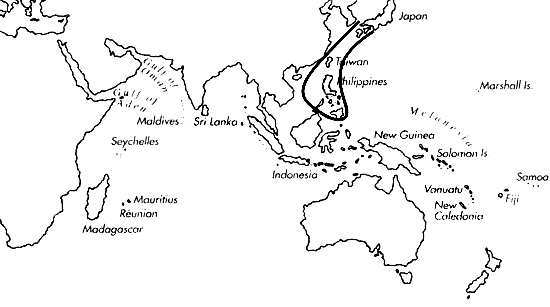
Skip Navigation Links
View access keys for this site.

Range: S. E. India and Sri Lanka to Singapore, Japan to Philippines, Solomon Islands, New Caledonia, Papua New Guinea, Western Australia, Arafura Sea and Queensland.
Description: usually conical, sometimes narrowly conical in form roseorapum (Pl. 28, Figs. 21-25) and rarely ventricosely conical in form urashimanus (Pl. 28, Fig. 13; see below); outline variably convex at adapical fourth, straight below; form roseorapum convex at adapical third and often with a concave left side near base. Shoulder angulate and undulate to tuberculate, the undulations or tubercles evenly spaced; weakly to prominently tuberculate in form roseorapum. Spire low, outline concave to somewhat sigmoid; in form roseorapum, apex often projecting above an otherwise almost flat spire. Larval shell of 3-3.25 whorls, maximum diameter 0.8-1.0 mm. About first 1.5 postnuclear whorls variably tuberculate; following whorls undulate. More strongly so toward shoulder. Teleoconch sutural ramps flat to slightly concave, with 1-2 increasing to 4-7 spiral grooves. weaker in late whorls. Last whorl with spiral ribs at base and a few widely spaced weak elevations above. In form roseorapum, last whorl glossier than in other variants.
| Shell Morphometry | ||
|---|---|---|
| L | 45-80 mm | |
| RW | 0.14-0.73 g/mm | |
| (L 45-79 mm) | ||
| RD | 0.50-0.60 | |
| (-f. roseorapum 0.49-0.56) | ||
| PMD | 0.85-0.96 | |
| (-f. urashimanus rarely to 0.83) | ||
| RSH | 0.02-0.10 | |
| (-f. roseorapum 0.01-0.07) | ||
Ground colour white to pale brown, or violet; in form roseorapum, ground pale violet, often suffused with pink, orange or reddish-brown. Last whorl with a broad yellow to brown spiral band on each side of centre, solid or interrupted and either distinct or merging with adjacent areas; apical band may extend to shoulder. In forrn roseorapum, bands reddish violet or orangish brown to bright orange. Central ground-colour band may be edged apically by small to large brown spots. Darker axial streaks of varying prominence may occur. Solid and dotted brown spiral lines frequently present in Indian Ocean shells (Pl. 28, Figs. 16, 17). rather sparse and inconspicuous in shells from the other localities. Larval whorls brown. Teleoconch sutural ramps with brown radial markings; immaculate spires intergrade with heavily maculated ones. Aperture white, often tinged with violet.
Periostracum of subadult specimens olive-grey, thin, slightly translucent, with widely spaced single or double rows of strong tufts around last whorl including shoulder and with strong axial ridges on sutural ramps. During growth, periostracum brown, thicker and opaque, with stronger tufts and with axial ridges also on last whorl. In form roseorapum, periostracum thinner; during growth, spirally aligned tufts become axially interlaced, forming a network of tufted patches on last whorl.
In form from Taiwan, radular teeth with a barb opposite a blade, short serration ending in a cusp somewhat posterior the blade, shaft with a narrow central waist, base with a spur. Form roseorapum from Philippines has a slightly narrower blade; its serration is as long as the blade, and the waist is anterior of the centre (Rolán, unpubl. observ.).
Habitat and Habits: In 25-240 m; form roseorapum reported from 100-240 m (Guillot de Suduiraut, pers. comm., 1992).
Discussion: The holotype of C. recluzianus (Pl. 28. Fig. 10) has faded yellow spiral bands and closely resembles specimens described as C. gloriakiiensis (Pl. 28, Fig. 14), although it lacks the brown spots at the apical edge of the central ground-colour band and its last whorl is somewhat narrower (0.52 vs. 0.53-0.60). Specimens conforming to the description of C. urashimanus have a rather uniform violet-brown colouration with often discontinuous darker brown spiral bands; their shoulder is sometimes distinctly tuberculate. Form gloriakiiensis and form urashimanus occur sympatrically from Japan to Taiwan, attain the highest relative weight, and are inseparable by soft part characters (Ninoimiya, pers. comm., 1983). Indian Ocean shells (Pl. 28, Figs. 16, 17) are comparatively light and have distinct brown or orange-brown spiral bands on a white ground. Shells from Australia (Pl. 28, Figs. 19, 20) are similar to those from Taiwan. Specimens referred to as C. roseorapum (Pl. 28, Figs 21-25) occur from the South China Sea to the Solomon Is. and intergrade with C. recluzianus in shape and colour pattern in Philippines. We therefore provisionally assign C. roseorapum to C. recluzianus as a form.

C. recluzianus range map
This section contains verbatim reproductions of the accounts of 316 species of Conus from the Indo-Pacific region, from Manual of the Living Conidae, by Röckel, Korn and Kohn (1995). They are reproduced with the kind permission of the present publisher, Conchbooks.
All plates and figures referred to in the text are also in Röckel, Korn & Kohn, 1995. Manual of the Living Conidae Vol. 1: Indo-Pacific Region.
The range maps have been modified so that each species account has it own map, rather than one map that showed the ranges of several species in the original work. This was necessary because each species account is on a separate page on the website and not confined to the order of accounts in the book.
Return to framed version (returns to search page)